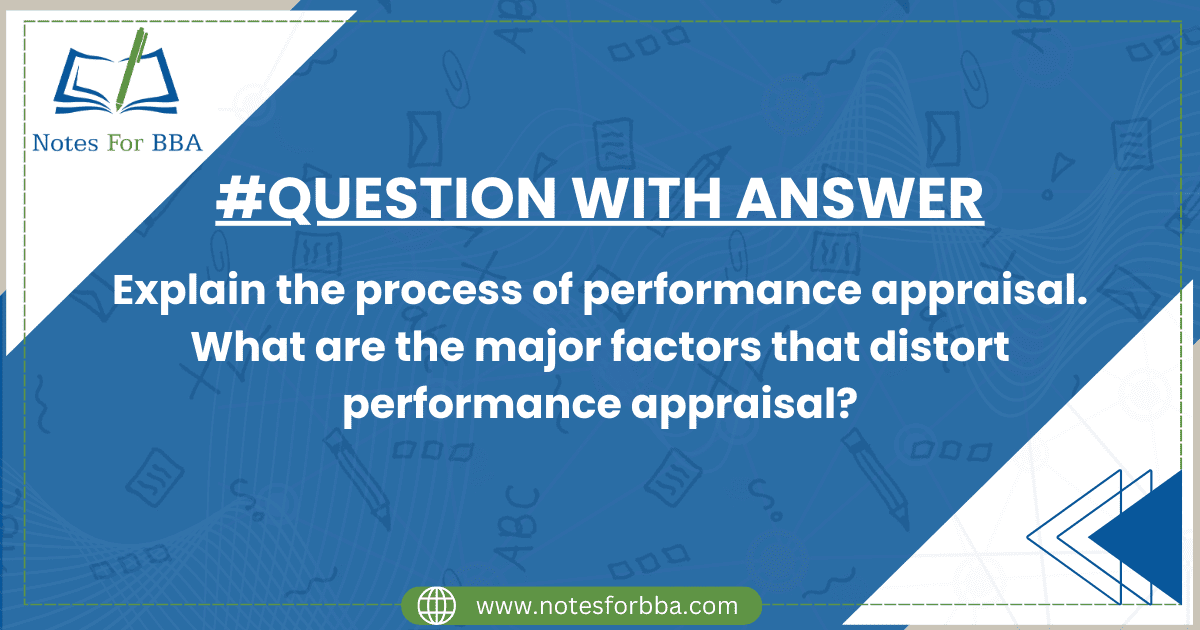Question: Explain the process of performance appraisal. What are the major factors that distort performance appraisal?
Answer:
Performance appraisal is like a “check-up” for employees to see how they’re doing in their jobs. It’s a structured way for organizations to evaluate an employee’s work, provide feedback, and plan for their growth. Here’s how the process typically works, explained in simple terms:
Setting Clear Goals
What Happens: At the start of the appraisal cycle, employees and their managers sit down to set clear, measurable goals. These goals should align with the employee’s role and the organization’s objectives.
Why It Matters: Clear goals give employees a roadmap to follow and make it easier to evaluate their performance later.
Monitoring Performance
What Happens: Throughout the appraisal period (e.g., a year), managers keep an eye on how employees are performing. This includes tracking progress toward goals, observing behavior, and noting achievements or challenges.
Why It Matters: Regular monitoring ensures that employees stay on track and allows for timely feedback if adjustments are needed.
Self-Evaluation
What Happens: Before the formal appraisal, employees are often asked to evaluate their own performance. They reflect on their achievements, challenges, and areas for improvement.
Why It Matters: Self-evaluation encourages employees to take ownership of their performance and helps managers understand the employee’s perspective.
Manager Evaluation
What Happens: The manager evaluates the employee’s performance based on the goals set earlier, as well as other factors like teamwork, communication, and problem-solving skills.
Why It Matters: This step provides a formal assessment of how well the employee has met expectations.
Feedback Session
What Happens: The manager and employee meet to discuss the evaluation. The manager shares feedback—both positive and constructive—and the employee has a chance to share their thoughts.
Why It Matters: This conversation helps employees understand what they’re doing well and where they can improve. It’s also an opportunity to discuss career growth and development.
Major Factors That Distort Performance Appraisal
Even with the best intentions, performance appraisals can sometimes go off track. Here are some common factors that can distort the process:
Bias
What Happens: Managers might let personal feelings or stereotypes influence their evaluation. For example, they might favor employees they like or judge others based on age, gender, or background.
Why It’s a Problem: Bias leads to unfair evaluations and can demotivate employees who feel they’re not being judged fairly.
Halo or Horn Effect
What Happens: The “halo effect” is when one positive trait (e.g., being friendly) makes the manager overlook other areas of performance. The “horn effect” is the opposite—one negative trait overshadows everything else.
Why It’s a Problem: This distorts the overall evaluation and doesn’t give a true picture of the employee’s performance.
Recency Bias
What Happens: Managers might focus only on what the employee has done recently, forgetting about their performance earlier in the appraisal period.
Why It’s a Problem: It ignores the employee’s overall contribution and can lead to unfair evaluations.
Leniency or Strictness
What Happens: Some managers are too lenient and give high ratings to everyone, while others are overly strict and rarely give high ratings.
Why It’s a Problem: Leniency makes it hard to identify top performers, while strictness can demoralize employees.
Lack of Clear Standards
What Happens: If goals or performance standards are unclear, managers might evaluate employees based on vague or subjective criteria.
Why It’s a Problem: Employees don’t know what’s expected of them, and evaluations can feel arbitrary.
All questions with answer of Chapter PERFORMANCE APPRAISAL – Click here

